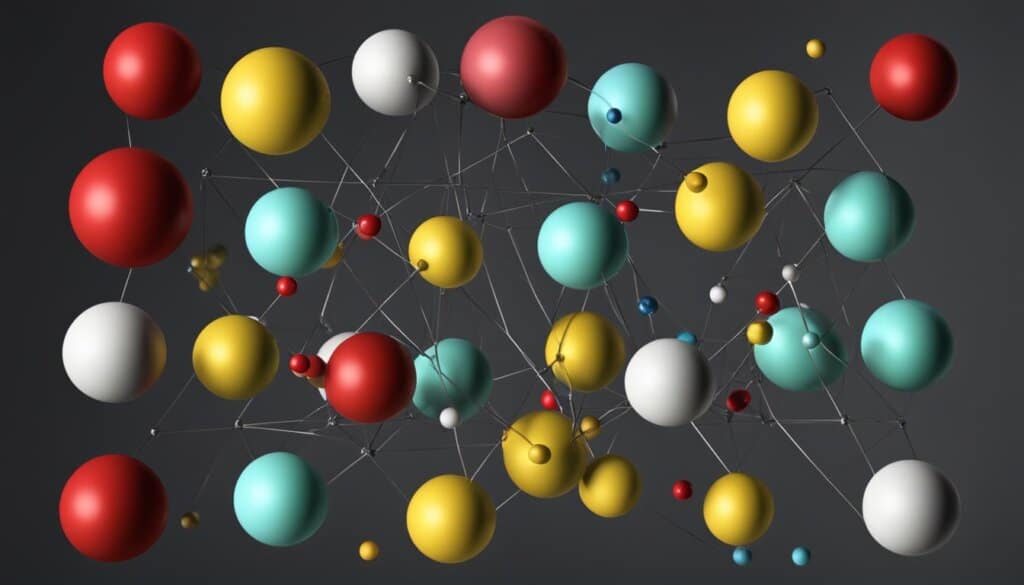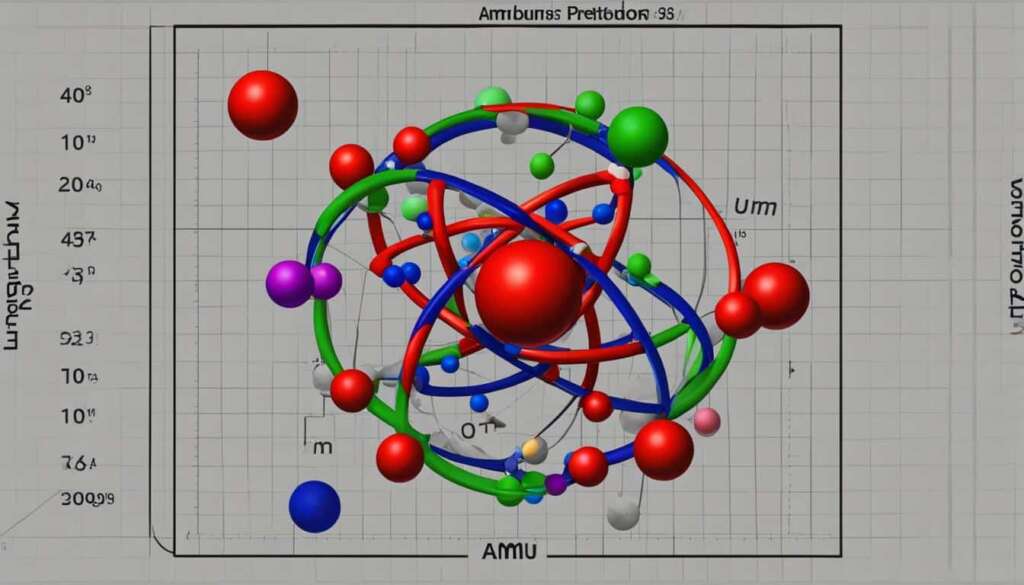Table of Contents
The atomic mass unit (AMU) is a fundamental concept in atomic physics and chemistry. It is essential for understanding the properties and behavior of atoms. In this article, we will dive into the details of AMU, its definition, and its significance in scientific research.
The AMU, also known as the dalton (Da) or the unified atomic mass unit (u), is a unit of measurement used to express the atomic mass of elements. It is defined as one-twelfth the mass of an atom of carbon-12 (12C), which has an AMU of 12. Each element in the periodic table has a unique atomic mass expressed in AMU or Da.
The concept of AMU evolved over time, with carbon-12 being chosen as the reference standard for atomic mass calculations. The unified atomic mass unit (u) is considered synonymous with AMU and is accepted as a physical constant in the International System of Units (SI) measurement system.
AMU plays a crucial role in distinguishing between isotopes, which are atoms of the same element with different numbers of neutrons. Isotopes have different atomic masses, and AMU provides a method for precisely characterizing and comparing these atomic masses.
Throughout history, scientists such as John Dalton and Wilhelm Ostwald contributed to the development of the concept of atomic mass and the atomic mass unit. However, it was the discovery of carbon-12’s stability and prevalence in nature that led to its adoption as the reference standard for atomic mass unit calculations.
In the following sections, we will explore the calculation of atomic mass, the significance of isotopes in relation to the atomic mass unit, and the importance of AMU in scientific research. Stay tuned for a comprehensive understanding of this fundamental unit of measurement!
What is Atomic Mass?
The atomic mass of an element is the sum of the number of protons and neutrons in its atom’s nucleus. It is expressed in atomic mass units (AMU) or daltons (Da). The atomic mass of an element is calculated relative to the mass of an atom of carbon-12, which is assigned a mass of 12 AMU.
The atomic mass of an atom is mainly determined by the mass of its nucleus, as electrons have a negligible mass compared to protons and neutrons. The mass of a proton or neutron is approximately 1 AMU.
The atomic mass of an individual atom may not be a whole number due to the interactions of particles within the nucleus and the inclusion of electron mass in the calculation.
“The atomic mass of an element is the sum of the number of protons and neutrons in its atom’s nucleus.”
History of the Atomic Mass Unit
The concept of the atomic mass unit (AMU) has undergone significant evolution throughout history. In 1803, John Dalton proposed a method of expressing relative atomic mass based on hydrogen-1 (protium). However, subsequent discoveries of isotopes created confusion in accurately expressing relative atomic masses. Another scientist, Wilhelm Ostwald, then suggested using oxygen as the reference standard.
However, in 1961, scientists reached a consensus to adopt carbon-12 as the reference standard for atomic mass unit calculations. Carbon-12 was chosen due to its stability and prevalence in nature. This paved the way for consistent calculations and comparisons of atomic masses across different elements. The use of carbon-12 as the reference standard ensures accuracy and uniformity in atomic mass measurements.
The atomic weight of an element, also known as the relative atomic mass, is calculated as the weighted average of the atomic masses of its isotopes. With carbon-12 as the reference standard, the atomic weight of an element can be determined by considering the proportions of its different isotopes.
Evolution of the Atomic Mass Unit
“The concept of atomic mass unit has evolved throughout history.”
Over time, scientists have refined the understanding and measurement of atomic masses, leading to the development of the atomic mass unit as a standardized unit of measurement. This has played a crucial role in enabling accurate comparisons and analysis of atomic masses in scientific research and various fields of study.
Importance of Carbon-12 as the Reference Standard
“Carbon-12 was chosen due to its stability and prevalence in nature.”
By using carbon-12 as the reference standard, scientists have established a consistent and reliable basis for measuring and calculating atomic masses. The stability and abundance of carbon-12 make it an ideal choice as a reference standard, allowing for precise comparisons and accurate determinations of relative atomic masses.
- John Dalton proposed the notion of relative atomic mass based on hydrogen-1.
- Wilhelm Ostwald suggested oxygen as the reference standard.
- Carbon-12 was adopted as the reference standard in 1961.
Isotopes and Atomic Mass Unit
Isotopes are atoms of the same element with different numbers of neutrons. The atomic mass unit is a useful tool for differentiating isotopes by expressing their relative masses. For example, an atom of uranium-235 (U-235) has an atomic mass unit of approximately 235, while an atom of uranium-238 (U-238) has an atomic mass unit of 238. The mass difference is due to the additional neutrons in the uranium-238 isotope.
Isotopes play a significant role in nuclear energy and atomic bomb technology. Understanding the differences in atomic mass unit allows scientists to distinguish between isotopes and study their properties and behaviors. The unique characteristics of isotopes contribute to various applications in fields such as medicine, archaeology, and environmental science.
It’s important to note that isotopes are not limited to uranium. Many other elements, including hydrogen, carbon, and oxygen, have naturally occurring isotopes with distinct atomic mass units. These isotopes provide valuable information about the origins and evolution of elements, as well as the processes that shape our universe.
The following table provides a comparison of the atomic mass units for uranium-235 and uranium-238:
| Isotope | Atomic Mass Unit |
|---|---|
| Uranium-235 (U-235) | 235 |
| Uranium-238 (U-238) | 238 |

As seen in the table, the difference in atomic mass units between uranium-235 and uranium-238 is crucial for the study of nuclear reactions and the production of energy. These isotopes have different properties and abundances, which are essential factors in determining their suitability for various applications.
Calculating Average Atomic Mass
The average atomic mass, also known as the relative atomic mass, is an important concept in chemistry. It represents the ratio of the average mass of an element’s atoms to a standard. Specifically, the atomic weight of an element is the weighted average of the atomic masses of its isotopes.
Let’s take the example of carbon. Carbon is a unique element as it exists in a mixture of two isotopes: carbon-12 and carbon-13. The atomic mass unit (AMU) of carbon-12 is 12, while the AMU of carbon-13 is 13.
To calculate the average atomic mass of carbon, we need to consider the natural abundance of each isotope. In other words, we take into account how common each isotope is in nature. The more abundant isotope, carbon-12, contributes more significantly to the average atomic mass. Using experimental data, scientists have determined that the average atomic mass of carbon is approximately 12.01 AMU.
Understanding the concept of average atomic mass is essential for various applications in chemistry. It helps guide the measurement of reactants and products in chemical reactions, providing crucial information for stoichiometry calculations.
| Isotope | Natural Abundance | Atomic Mass (AMU) |
|---|---|---|
| Carbon-12 | 98.93% | 12 |
| Carbon-13 | 1.07% | 13 |
The table above illustrates the natural abundance and atomic masses of carbon-12 and carbon-13 respectively. By considering both the natural abundance and atomic masses, scientists can calculate the average atomic mass of carbon based on the weighted contributions of each isotope.
By understanding how to calculate average atomic mass, chemists can accurately analyze and work with elements and their isotopic compositions. This knowledge forms the foundation for many important fields of study, including materials science, environmental chemistry, and biochemistry.
Having a solid understanding of average atomic mass is crucial for anyone studying or working in the field of chemistry. It allows for accurate measurements and calculations, providing the basis for further scientific advancements and discoveries.
Significance of Atomic Mass Units in Science
Atomic mass units serve as a crucial unit of measurement for atomic masses in the field of science. By using standardized measurements, scientists can effectively compare and analyze experimental data, ensuring consistent and accurate results across different laboratories. This uniformity is made possible due to the adoption of atomic mass units, which allow for precise comparisons and reliable data interpretation.
One notable technique that employs atomic mass units is mass spectrometry. This powerful analytical tool enables scientists to obtain precise measurements of atomic masses, allowing for advancements in various scientific disciplines. With the help of mass spectrometry, researchers can delve into the intricate details of atomic structures, uncovering valuable insights and contributing to the development of new scientific knowledge.
Standardized units play a particularly significant role in chemistry, where the numerical relationships between atoms greatly influence the outcome of chemical reactions. By utilizing atomic mass units, scientists can accurately measure and determine the reactants and products involved in a chemical process. This precise measurement and analysis enable researchers to make informed decisions, drive innovation, and devise strategies for practical applications.
In conclusion, the use of atomic mass units as a unit of measurement imparts standardization and reliability to scientific investigations. Through techniques like mass spectrometry and the comparison of experimental data, scientists can unlock the mysteries of atomic structures and pave the way for breakthroughs in multiple scientific disciplines.
FAQ
What is an atomic mass unit (AMU)?
An atomic mass unit (AMU) is a measure of the atomic mass of an element. It is also known as the dalton (Da) or the unified atomic mass unit (u).
How is atomic mass calculated?
The atomic mass of an element is the sum of the number of protons and neutrons in its atom’s nucleus. It is expressed in atomic mass units (AMU) or daltons (Da).
Why is carbon-12 chosen as the reference standard for atomic mass calculations?
Carbon-12 was chosen as the reference standard for atomic mass unit calculations due to its stability and prevalence in nature.
What are isotopes?
Isotopes are atoms of the same element with different numbers of neutrons. The atomic mass unit is a useful tool for differentiating isotopes by expressing their relative masses.
How is the average atomic mass of an element calculated?
The average atomic mass of an element is the weighted average of the atomic masses of its isotopes, calculated based on the natural abundance of each isotope.
What is the significance of atomic mass units in science?
Atomic mass units play a vital role in science as a unit of measurement for atomic masses. They allow for consistent comparisons, accurate data analysis, and precise measurements using techniques such as mass spectrometry.












